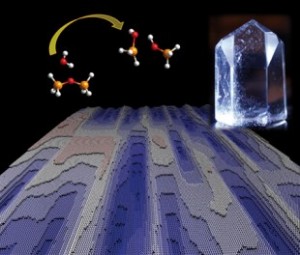
Over millions of years, butterflies evolved sophisticated cellular mechanisms to produce brightly colored wings for mating and camouflage. iStock photo by Borut Trdina
A June 13, 2016 news item on Nanowerk announced a discovery about the physics of colour,
A team of physicists that visualized the internal nanostructure of an intact butterfly wing has discovered two physical attributes that make those structures so bright and colorful.
“Over millions of years, butterflies have evolved sophisticated cellular mechanisms to grow brightly colored structures, normally for the purpose of camouflage as well as mating,” says Oleg Shpyrko, an associate professor of physics at UC San Diego, who headed the research effort. “It’s been known for a century that the wings of these beautiful creatures contain what are called photonic crystals, which can reflect light of only a particular color.”
But exactly how these complex optical structures are assembled in a way that make them so bright and colorful remained a mystery.
A June 10, 2016 University of California at San Diego news release (also on EurekAlert), which originated the news item, describes how the mystery was solved,
In an effort to answer that question, Shpyrko and Andrej Singer, a postdoctoral researcher in his laboratory, went to the Advanced Photon Source at the Argonne National Laboratory in Illinois, which produces coherent x-rays very much like an optical laser
By combining these laser-like x-rays with an advanced imaging technique called “ptychography,” the UC San Diego physicists, in collaboration with physicists at Yale University and the Argonne National Laboratory, developed a new microscopy method to visualize the internal nanostructure of the tiny “scales” that make up the butterfly wing without the need to cut them apart.
The researchers report in the current issue of the journal Science Advances that their examination of the scales of the Emperor of India butterfly, Teinopalpus imperialis, revealed that these tiny wing structures consist of “highly oriented” photonic crystals.
“This explains why the scales appear to have a single color,” says Singer, the first author of the paper. “We also found through careful study of the high-resolution micrographs tiny crystal irregularities that may enhance light-scattering properties, making the butterfly wings appear brighter.”
These crystal dislocations or defects occur, the researchers say, when an otherwise perfectly periodic crystal lattice slips by one row of atoms. “Defects may have a negative connotation, but they are actually very useful in improving materials,” explains Singer. “For example, blacksmiths have learned over centuries how to purposefully induce defects into metals to make them stronger. ‘Defect engineering’ is also a focus for many research teams and companies working in the semiconductor field. In photonic crystals, defects can enhance light-scattering properties through an effect called light localization.”
“In the evolution of butterfly wings,” he adds, “it appears nature learned how to engineer these defects on purpose.”
The researchers have made this image illustrating their work available,

Scales from the wings of the Emperor of India butterfly consist of “highly oriented” photonic crystals. Photos by Andrej Singer, UC San Diego
Here’s a link to and a citation for the paper,
Domain morphology, boundaries, and topological defects in biophotonic gyroid nanostructures of butterfly wing scales by Andrej Singer, Leandra Boucheron, Sebastian H. Dietze, Katharine E. Jensen, David Vine, Ian McNulty, Eric R. Dufresne, Richard O. Prum, Simon G. J. Mochrie, and Oleg G. Shpyrko. Science Advances 10 Jun 2016: Vol. 2, no. 6, e1600149 DOI: 10.1126/sciadv.1600149
This paper is open access.
